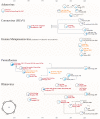Visualizing clinical evidence: citation networks for the incubation periods of respiratory viral infections
- PMID: 21559339
- PMCID: PMC3084881
- DOI: 10.1371/journal.pone.0019496
Visualizing clinical evidence: citation networks for the incubation periods of respiratory viral infections
Abstract
Simply by repetition, medical facts can become enshrined as truth even when there is little empirical evidence supporting them. We present an intuitive and clear visual design for tracking the citation history of a particular scientific fact over time. We apply this method to data from a previously published literature review on the incubation period of nine respiratory viral infections. The resulting citation networks reveal that the conventional wisdom about the incubation period for these diseases was based on a small fraction of available data and in one case, on no retrievable empirical evidence. Overall, 50% of all incubation period statements did not provide a source for their estimate and 65% of original sources for incubation period data were not incorporated into subsequent publications. More standardized and widely available methods for visualizing these histories of medical evidence are needed to ensure that conventional wisdom cannot stray too far from empirically supported knowledge.
Conflict of interest statement
Figures




References
-
- Valtin H. “Drink at least eight glasses of water a day.” Really? Is there scientific evidence for “8×8”? Am J Physiol Regul Integr Comp Physiol. 2002;283:R993–1004. - PubMed
-
- Lessler J, Brookmeyer R, Perl TM. An evaluation of classification rules based on date of symptom onset to identify health-care associated infections. Am J Epidemiol. 2007;166:1220–9. - PubMed
-
- Lessler J, Brookmeyer R, Reich NG, Nelson KE, Cummings DAT, et al. Identifying the probable timing and setting of respiratory virus infections. Infect Control Hosp Epidemiol. 2010;31:809–15. - PubMed
-
- Nishiura H. Determination of the appropriate quarantine period following smallpox exposure: an objective approach using the incubation period distribution. International Journal of Hygiene and Environmental Health. 2009;212:97–104. - PubMed
-
- Ferguson N, Cummings D, Cauchemez S, Fraser C, Riley S, et al. Strategies for containing an emerging influenza pandemic in southeast asia. Nature. 2005;437:209–214. - PubMed
Publication types
MeSH terms
Grants and funding
LinkOut - more resources
Full Text Sources

